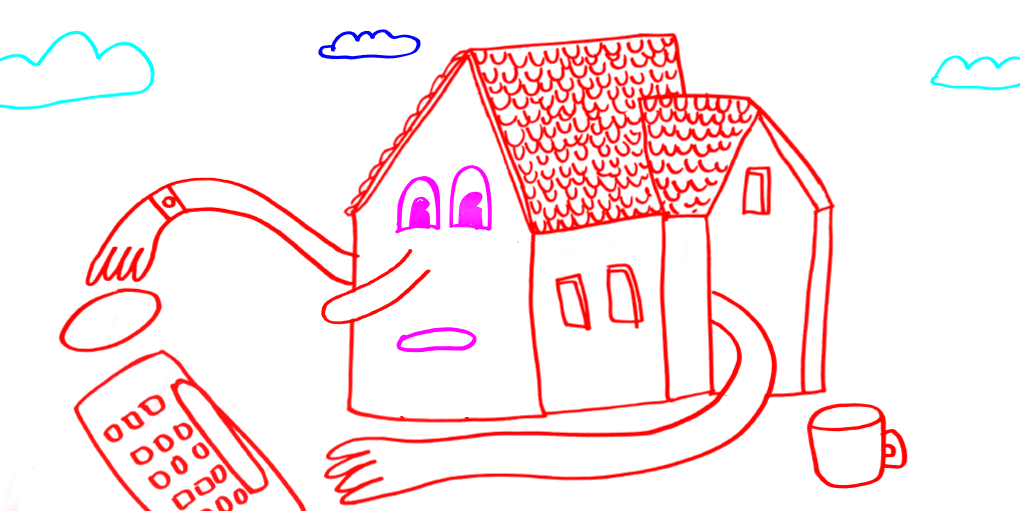
It’s been nearly 2 months since Fuzzy Math began working remotely. And while April has somehow both crawled and flown by, we’re slowly starting to get adjusted to the new normal of “office” and “home” being one and the same.
We checked in with our team to answer the questions: Has working from home changed how you work? What have you learned so far?

For the first time in many years, I set up a designated space to do work in at home. I think since partway through college I’d always been elsewhere to study or get work done (school library, computer lab, an office) so it didn’t seem like a necessity at home for a long time. Obviously that’s changed recently, so I got a desk for my room.
I also try to put on real pants during the day and sweats/joggers as soon as I’m done with work. It helps break up the day I think?

Working from home under normal circumstances requires a ton more self-control. Add in the fact that we’re spending pretty much all our time at home, and the fine line between work and personal gets erased completely. To keep my sanity over this last month … wait 2 months 🤦♂️… I’ve been super vigilant about time-boxing my day. I start every morning like I normally would by getting ready. Then I make lists! I prioritize what should get done, and I tell myself, “from 10 am to noon, start working on those landing page wireframes.” I don’t always stick to my schedule and I get distracted (a lot), but having structure helps — even if I don’t always stick to it.

Sounds pretty simple, but opening up the blinds and windows during work hours can be a huge help. I live in a small apartment with no outdoor space, so feeling a fresh breeze and having a lot of natural light can really help boost my mood. I also am way more consistent with making my bed every morning. Its an indication to me that my day has officially started.

Working from home feels different now then it did ever before. There is a different mindset, one being of having the choice to work from home vs. the alternative (not having the choice, lol). Personally I am just now getting used to the idea that this may be for longer than I considered in my mind. And an important part of that adjustment is letting go of how I want or wish things to be.
One thing I have come to realize is how much I enjoy the energy of being around other humans. There is a certain level of productivity that I think benefits from being around people in close physical proximity. Our computers can provide us with the ability to still communicate in some forms, but they cannot respectively replace the importance of real-time, real-space human interaction.
The second thing I learned is how important sound is for my productivity. Working from home with a partner that is on the phone most of the day has been a hard adjustment. Being in control of what sounds and noises you are being exposed to during the day is very important to focus.

It was so much easier to keep a routine when I had to physically go to places outside my home. Now, I’ve had to make adjustments and create new routines for myself even though I’m just going to be at home all day 🙃. Also, I used to watch the news every morning as I got ready, but now I’ve pretty much stopped watching the news completely just to keep my mind at peace.

I’ve never loved working from home. I don’t feel as productive as when I’m in the office, I struggle with keeping focused (There’s laundry to do! Dishes to put away!), and I find myself craving side conversations with my friends in the office. But now that we’ve been here for a while, there’s definitely a few things that I’ve learned:
Even when we were still in the office, I was never good about turning “off” at the end of the day — I was often the last one in the office, just trying to finish that last thing while I’m still in the zone. That’s definitely gotten worse when there’s no physical barrier between “work” and “home”. At Rachel Shaver’s suggestion, I’m trying to be really intentional about closing my computer at the end of the day and doing something else for a little bit. Even if I come back to my computer 10 minutes later, that little bit of separation makes it more likely that I won’t just keep working way later than I should be.
And secondly, for me, it’s been really nice to have my partner also working from home. Once I got over the initial annoyance at having to coordinate who’s client calls take priority, having someone else around definitely makes me feel a bit more like I’m working in an office. I’ve also been trying to be more intentional about checking in with coworkers that I’m not actively on a project with, even if it’s just a Slack message. I miss those water-cooler conversations, or just being able to turn around and ask someone a question. It’s a learning curve for sure.

In a household with two parents both working remotely, and a 1.5 year old and 3 year old conspiring against them at every turn, it’s less about finding ways to delineate between work and personal time, and more about carving out functional work time. Assessing every meeting and task to understand whether it can be done while watching kids or whether I need focus time, communicating as much as possible with both the family and the team, and figuring out how to find some sense of equitable time sharing with my partner. Thankfully, we have a team that’s understanding when I’m a few minutes late because the baby just woke up from a nap (again), and the logistics of collaborating remotely aren’t particularly unfamiliar.

I’m not someone who could ever work from home full-time under normal circumstances. I very much prefer the routine of waking up and commuting to the office most days. I like the change of scenary, and frankly the exercise too since I commute by foot and public transportation. I also like just being in person with my coworkers. I feel like that fits my work style better. I generally only work from home when necessary, like when I’m sick or need a breather. So working from home all the time during quarantine has been a bit stressful as I try to establish a new routine. In the first few weeks I felt like my days were blending together because I had no delineation between work day and night. Now I’m trying to find ways to make things feel more structured. Getting dressed in regular clothes instead of pajamas helps. So does going on walks. So does working within the typical 9-5 like I normally would, and taking a lunch break where I don’t look at my computer the whole time. I’m slowly learning new ways to ‘be at home’ and ‘be at work’ when those things occur in the same place.

I’m quarantining with a wife who’s doing her best to work a full-time job along with a high energy almost three-year-old and a nearly six-month-old.
There have been so many changes that have been forced onto me (and my wife) due to our new 24-hour co-workers. The biggest, I think, is that I used to be able to separate ‘work’ priorities from ‘family’ priorities, but the quarantine has really forced me to merge those into the same list. Balancing email time, work review time, ops time, meal prep time, nap time, play time, bed time, diaper change time, etc. has been the challenge of the last few weeks. It’s a constant prioritization wrestling match between me and the kids and me and my wife.
The kids are generally winning, with work coming in a distant second. We’re still trying to be the parents we want to be: limited screen time, routines around eating and bedtimes, and giving each kiddo the dedicated time they need from each of us. That has left work in a place where I need to determine what’s a “must-do” versus a “nice-to-do.” My approach before the quarantine was very, very different from this new approach, so it’s been a tough change to get used to (in a very compressed timeline). I am far from perfect in identifying which to-do should go into which bucket, but I’ve (sadly) had a lot of practice these last few weeks.
More than anything else post-quarantine, I am so very excited to get back to being able to separate work priorities from work priorities and have dedicated time for each.
If you’re like us and are still trying to adjust to working remotely, we’ve put together some thoughts for you in our Remote UX Design Toolkit: from how to host collaborative creative sessions remotely to our best Zoom tips and tricks.
Got another topic that you’d like our take on? We’d love to hear from you! Send us an email or tweet, and we’ll put our brains to good use.